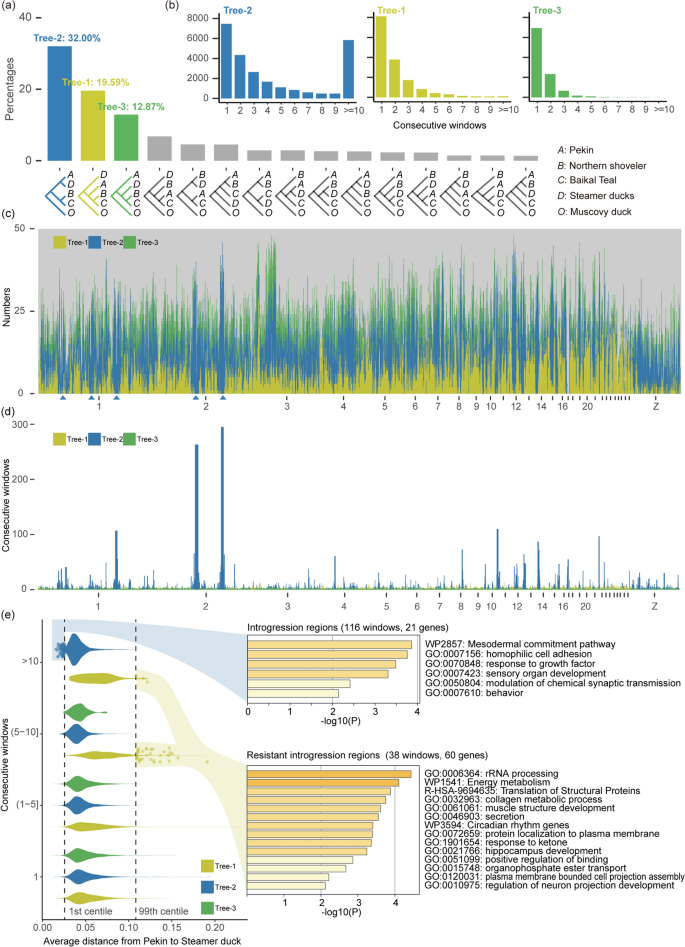The three main classifications of the genus Anas according to different studies are summarized in Fig. 1a. Our phylogenetic analysis was performed on 3,971,317 whole-genome 4D sites, and the resulting phylogenetic tree clustered the Baikal teal and Northern shoveler together with the other Anas species, rather than with the two Steamer ducks (genus Tachyeres) (Fig. 1b). The same topology was obtained when using 191,205 Z chromosome 4D sites or whole-genome CDS (25,308,862 bp) (see Additional file 1: Fig. S1). Subsequently, we performed a phylogenetic analysis using various window sizes and obtained three primary tree topologies, as shown in Fig. 1c: t1 [(Muscovy duck, Steamer ducks), ((Baikal teal, Northern shoveler), Sub-Anas))]; t2 [((Muscovy duck, (Baikal teal, Northern shoveler)), (Steamer ducks, Sub-Anas)]; and t3 [(Muscovy duck, ((Steamer ducks, (Baikal teal, Northern shoveler)), Sub-Anas))]. The phylogenetic tree based on coalescence theory coincided with the t2 topology at the N2 node, where the Steamer ducks first clustered with the Pekin duck and its allies (Sub-Anas) and then joined the Baikal teal and Northern shoveler branches (see Additional file 1: Fig. S1). In addition, a high level of alternative topologies (t2 and t3) was observed at the N2 nodes with varying window sizes. The frequency of windows with the t2 topology was slightly higher than that with the t1 topology for the whole genome, and the frequency of windows with the t3 topology gradually increased as the window size decreased. However, the t2 topology was dominant on the Z chromosome, with more than 75% of the windows of large sizes (100 kb, 500 kb, and 1 Mb) having this topology (Fig. 1d). This phylogenetic incongruence indicated extensive incomplete lineage sorting (ILS) and potential hybridization during the early stages of differentiation of Anas [24].
To further investigate the window tree discordances, we retained Muscovy duck, the two Steamer ducks, Baikal teal, Northern shoveler, and Pekin duck from the 10-kb window trees. All 79,648 trees consisted mainly of 15 topologies, except for seven trees that separated the Falkland steamer duck from the White-headed steamer duck. Similarly, 19.6% of the trees grouped Baikal teal, Northern shoveler, and Pekin duck (tree-1); 32.0% of the trees grouped Steamer ducks and Pekin duck together (tree-2); and 12.9% of the trees grouped Steamer ducks, Baikal teal, and Northern shoveler together (tree-3) (Fig. 2a). In contrast to tree-1 and tree-3, a significant proportion of tree-2 (70.7%, 18,027 out of 25,485 trees) was scattered in consecutive windows. Specifically, 22.9% (5840 out of 25,485 trees) of tree-2 were found in the highly consecutive windows (≥ 10), whereas only 0.7% (103 out of 15,607 trees) of tree-1 and no tree-3 was present (Fig. 2b). These distribution patterns of tree-2 suggest that hybridization had an effect on phylogenetic conflicts [25] and the ABBA-BABA statistics further validated the presence of introgression (see Additional file 2: Table S1). Therefore, the high proportion of tree-2 could be viewed as a sign of introgression and, thus, the proportions of tree-1, tree-2, and tree-3 in different genome regions were determined (Fig. 2c). Numerous genomic locations showed a high percentage of tree-2, especially three regions on chromosome 1 and two regions on chromosome 2, which were almost entirely composed of tree-2. In addition, tree-2 dominated the Z chromosome, with tree-1 composing a small percentage of the Z chromosome (Fig. 2c). Correspondingly, chromosome 2 had the two largest continuous windows, which included 295 and 263 consecutive windows (Fig. 2d). Moreover, the average genetic distance from the most recent common ancestor (MRCA) of Sub-Anas to its MRCA with Baikal teal and Northern shoveler in the 295 consecutive windows was increased (permutation P value < 0.0001), which indicated that the introgression was from Tachyeres to Anas (see Additional file 3: Table S2).
Ancient introgression from Tachyeres to Anas and its potential influences. a Percentages of 15 phylogenetic tree topologies for six ducks (Pekin, Northern shoveler, Baikal teal, two Steamer and Muscovy ducks). b Distributions of three primary topologies in consecutive windows. c Numbers of three primary topologies in 500-kb sliding windows across the genome. d Genomic distributions of consecutive windows. e The left section displays the average evolutionary distance between Pekin duck and two Steamer ducks for three primary topologies in different consecutive windows. The right section shows the pathway enrichment results for genes from introgression or resistant introgression regions
Furthermore, only 21 genes overlapped with 116 introgression windows (see Additional file 4: Table S3). Concurrently, 60 genes overlapped with 38 resistant introgression windows. These results indicate that the regions with a low gene density were more likely to have undergone introgression, whereas the regions with a high gene density had been less susceptible to introgression. The genes in the introgressed regions were enriched for pathways related to response to growth factor, sensory organ development, behavior, etc., and the genes in the resistant introgression regions were enriched for pathways related to rRNA processing, energy metabolism, muscle structure development, circadian rhythm genes, etc. These findings suggest that the early introgression from Tachyeres has had a strong impact on the behavior, size, and perception of their surroundings of Anas species, while their foundational functions may have remained unaffected.






Add Comment